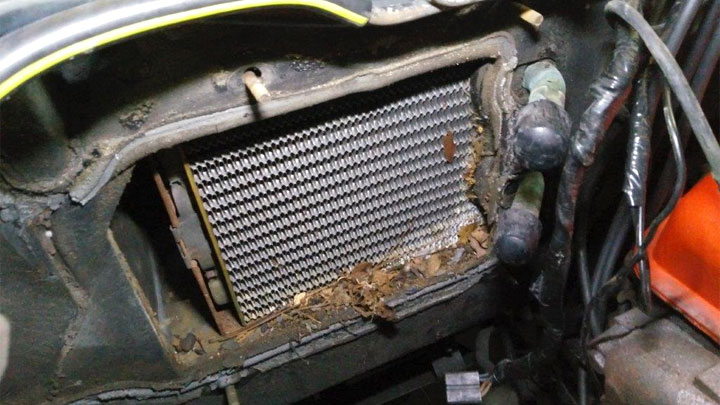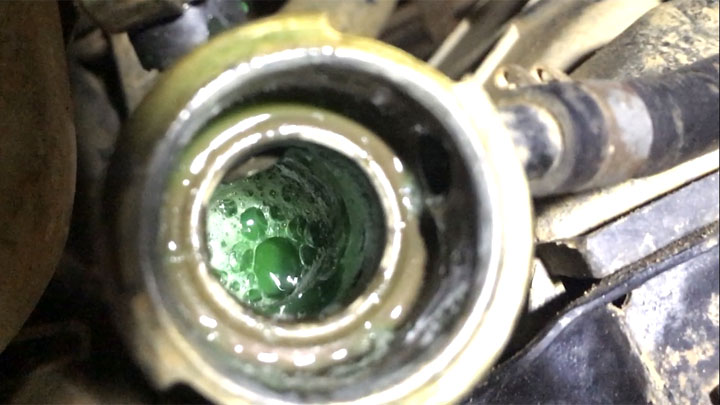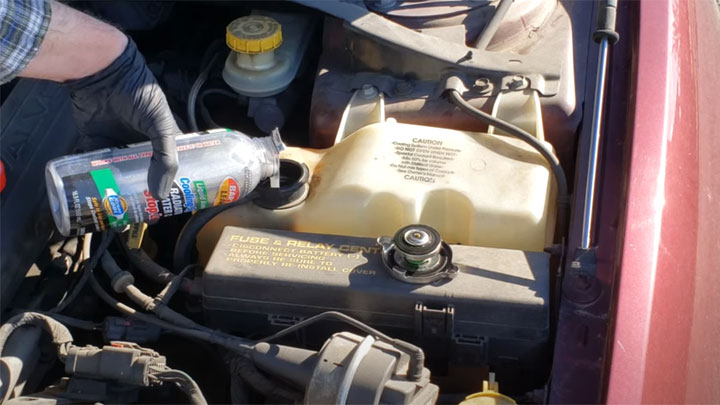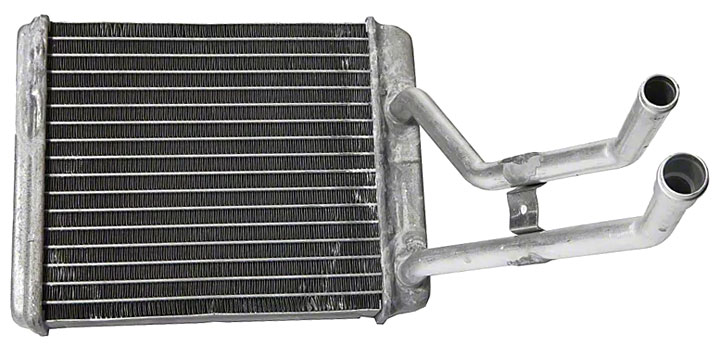5 Symptoms of a Clogged Heater Core (and Common Causes)
As winter sets in, a functioning heating system is something to not take for granted. But when frigid temps reveal a clogged heater core, your commute gets that much worse. This vital component regulates cabin warmth, so blockages cripple comfort.
Continue reading to learn the common symptoms of a clogged heater core, what causes the issue, and how much it will cost to either flush or replace the heater core.

What is a Heater Core?
A heater core is a heat exchanger that radiates heat into a vehicle’s cabin. This heat originates from engine temperature coolant that flows throughout a vehicle’s heater core, via small tube-like passages.
A vehicle’s blower motor forces air across a heater core, dispelling heat through the adjacent duct-work. As a result, warm air fills a vehicle’s cabin, thereby stopping winter’s chill in its tracks. The end result is a comfortable commute for drivers, even in the face of bitter cold seasonal temperatures.
A heater core features inlet and outlet junctions at a vehicle’s firewall. Coolant lines are affixed at these junctions, courtesy of hose clamps or quick-connect unions.

Some vehicles regulate the flow of coolant through these hoses, by way of a specialty heater control valve. This valve is typically controlled by vacuum, or electrical means, and actuates in response to control head input.
The heater core itself is mounted deep beneath a vehicle’s dash, in close relation to the interior side of the firewall. As a result, heater core-related issues are typically diagnosed by analyzing one or more symptoms associated with the failure at hand.
Therefore, it is extremely important to recognize and understand the various symptoms associated with a faulty or obstructed heater core.
Clogged Heater Core Symptoms
There are numerous signs that often accompany the presence of a clog within a vehicle’s heater core. While the symptoms associated with such a failure often differ on a case-by-case basis, several symptoms tend to be prevalent in the majority of cases.
The following are several of the most common symptoms of a clogged heater core or a bad heater core in general.
#1 – No Heat

The most common symptom of a clogged heater core is a general lack of heat. When coolant is unable to circulate through a vehicle’s heater core, heating efficiency is severely diminished.
As such, one can expect a frigid commute, with little reprieve at the hands of their hobbled heating core.
#2 – Sub-Par Heat in Extreme Cold

In certain cases, your vehicle’s heat might prove sufficient during periods of mildly cold weather, only to fall flat when the extreme cold takes hold. This condition is indicative of a partially clogged heater core.
While enough warm coolant is allowed to flow to provide some heat, the system’s overall heating capacity is greatly reduced. In such instances, a thorough flush will often restore a system to full functionality.
#3 – Possible Overheating

Can a bad heater core cause overheating? In most cases, a clogged heater core, by itself, will not cause overheating. However, when combined with additional issues, engine overheating may result.
This is often the case when cooling system efficiency is already compromised, such as in the case of a faulty water pump or a partially clogged radiator.
#4 – Foggy Windows
One of the first signs you may notice in cool weather are foggy windows. When the heater core is not functioning as it should, it can’t provide enough heat to the cabin, causing condensation to build up on the inside of the windows. This condensation may even turn to frost on the inside windshield.
This type of fogging will be persistent and not just for a couple minutes while normally warming up your vehicle. This particular symptom can impair your visibility while driving and make it difficult to see clearly so caution must be taken.
#5 – Wet Carpets
While not too common, a clogged or faulty heater core can sometimes leak coolant, which can seep into your car’s interior and cause the carpets to become wet or damp. This can lead to unpleasant odors and potential mold growth.
Check for moisture near the passenger footwell, as this is a common location for heater core leaks.
What Causes a Heater Core to Clog
There are numerous potential causes of a clogged heater core. While each of these causes differs in origin, all lead to the same troubling condition, which must be remedied in order to restore heater core operation back to peak efficiency.
The following are several of the most common causes of a heater core leak.
#1 – Rust/Scale Build-Up

Corrosion of any type is extremely detrimental to a vehicle’s cooling system as a whole. However, heat exchangers found within this system are especially prone to problems resulting from rust and scale build-up.
This includes the heater core, which tends to clog quite easily. Rust and scale build up of this type often result from the prolonged use of water within a vehicle’s cooling system.
See Also: How to Remove a Rusted Bolt
#2 – Mixing of Oil/Coolant

When oil and coolant mix, sludge is created as a byproduct. This sludge quickly spreads throughout a vehicle’s cooling system, including the heater core.
Due to the density of this sludge, clogging often occurs, ultimately slowing or eliminating the flow of coolant throughout the heater core. Gasket failure is by far the most common cause of oil/coolant mixing.
#3 – Use of a Stop Leak Product

Many vehicle owners choose to use various stop leak products to eliminate cooling system leaks of one type or another. However, these products tend to cause clogging within a vehicle’s heater core.
This is especially true when more than the recommended amount of such products are used. Stop leak products can also clog a vehicle’s radiator in a very similar manner.
#4 – Restricted Hoses
Heater hoses are responsible for transferring coolant from the engine to the heater core. These hoses play an important role in maintaining adequate coolant flow, which allows your car’s heating system to work as it should. Over time, wear and tear, debris, and other factors can cause these hoses to become restricted or even collapsed.
When the hoses become restricted, the circulation of coolant through the heater core may be reduced or even stopped and can lead to the issues mentioned above.
Heater Core Flush Cost
In certain instances, a clogged heater core can be flushed, thereby restoring a vehicle’s heating efficiency. In other cases, a heater core must be replaced, as efforts to alleviate a clog through flushing, have proved futile.
In any event, it costs significantly less to flush a heater core, than it does to replace the affected heater core in its entirety. This is due to the significant amount of time that is required to replace most heater cores and the labor cost that such an expenditure of time commands.
In general, a heater core flush typically costs somewhere in the neighborhood of $75-$100. However, this price also varies depending upon the make and model of the vehicle in question, as well as one’s choice of service center.
For actual cost, contact the dealership or service center that has worked on your car in the past or simply Google “heater core flush near me” and obtain at least a couple estimates from local mechanics.
Heater Core Replacement Cost
Best places to order parts? See: 19 Best Online Auto Parts Stores

In the event that a traditional heater core flush yields no results, and you are still left without sufficient heat, heater core replacement might be necessary. This, unfortunately, is an expensive proposition. Due to the heater core’s location deep within a vehicle’s dash, much time and effort are required for removal.
As such, the labor costs associated with heater core replacement tend to be quite extensive. However, the exact price of these repairs can vary greatly from one model of vehicle to the next.
Most shops charge for the number of labor hours specified by a vehicle’s manufacturer when completing repairs. In certain cases, heater core replacement can require as much as 7-8 hours of labor.
On average, heater core replacement costs approximately $750-$1,100. This includes both the cost of a heater core itself and the labor associated with installation.
The lower end of this price spectrum reflects replacement with relatively cheap parts/labor, while the higher cost is representative of replacement in a dealership setting, with the use of OEM components.
How to Bypass the Heater Core
At times, bypassing the heater core is a temporary solution when you experience a clogged or leaking heater core. Here’s how to do that:
#1 – Locate the Heater Core Hoses
Find the two hoses that connect to the heater core at the firewall in the engine compartment. These hoses are typically the same diameter and run from the engine to the passenger compartment.
#2 – Disconnect the Hoses
Carefully disconnect the hoses from the heater core. Be cautious of any coolant spills, as the coolant can be hot and cause burns.
#3 – Connect the Hoses Together
Using a suitable connector, join the two hoses together. Make sure the connection is secure and doesn’t have any leaks.
#4 – Secure the Hoses
Use hose clamps to fasten the hoses securely to the connector. Ensure the connection is tight and leak-free.
#5 – Test the Bypass
Start your engine and allow it to reach operating temperature. Check for leaks around the connection and ensure that coolant is circulating properly.
Keep in mind that bypassing the heater core is a temporary fix and should not be considered a long-term solution. While it may prevent further damage to your engine due to clogged or leaking heater cores, it also disables the heating function in your vehicle.
As with any car problem, it’s important to address the underlying issue and properly repair or replace the heater core as soon as possible to restore your vehicle’s heating capabilities.
- P0480 Code (Symptoms, Causes, and How to Fix) - Apr 19, 2024
- Car Temperature Gauge Stopped Working? (Here’s Why) - Apr 15, 2024
- Ignition Coil vs Coil Pack (What’s the Difference?) - Apr 8, 2024

My truck is blowing hot air on the passenger side and the driver side is blowing cold
What is the year, make, and model of your truck? Is your truck equipped with dual zone climate control?
I have a 2007 dodge ram with new water pump thermostat and radiator but the heat is low also the thermostat seems like an extremely long time to fully open
Check to make sure you have the right thermostat for that truck. Check to make sure the thermostat was installed in the correct orientation.